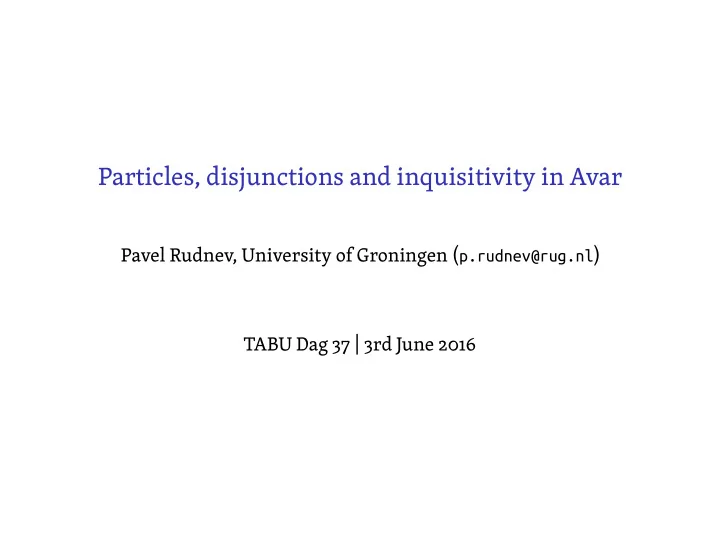

Particles, disjunctions and inquisitivity in Avar TABU Dag 37 | 3rd June 2016 Pavel Rudnev, University of Groningen ( p.rudnev@rug.nl )
Introduction Research programme on logical constants Tradition Recent developments Mitrović 2014; Mitrović 2015, a.o.) a.k.a. superparticles (Mitrović) ▶ logical tradition: conjunction and disjunction treated on a par ▶ ditto for the syntax of conjunction and disjunction ▶ conjunction is more basic than disjunction (Szabolcsi 2015; ▶ all action is performed by quantifjer particles (Szabolcsi 2015),
Superparticles µ /MO ▶ alternative activation ▶ obligatory (possibly recursive) exhaustifjcation ▶ ⟦ µ ⟧ = λp [ X R ( p )] ⊢ λp [ p ∧ ¬ X ( p )] ▶ X R is an exhaustifjcation operator (cf. Chierchia 2013) κ /KA ▶ non-tautological disjunction addition ▶ ⟦ κ ⟧ = λp [ p ∨ ¬ p ]
Why these particles? conjunction (Mitrović and Sauerland 2014) =nigi marking: two empirical claims obligatorily strong/exclusive (Mitrović 2015) ▶ crosslinguistic argument ▶ Avar forms the core of the argument for both the structure of ▶ and the analysis of exclusive disjunction (Mitrović 2015) ▶ complex disjunction markers containing an additive particle are ▶ =nigi -marked pronouns are negative (Alekseev and Ataev 1997 a.o.)
Aims for today ▶ show both claims to be false ▶ sketch a path towards dispelling the confusion
Additivity, exhaustifjcation and XOR disjunction, where J is Den Dikken’s (2006) Junction head: (1) JP NPI/additive NPI/additive coordination ▶ Mitrović (2015) proposes the following structure for exclusive ����������������������������������������������������������������������������� ����������������������������������������������������������������������������� [ µ P µ 0 XP ] ][ J 0 [ κ P κ 0 [ [ κ P κ 0 [ µ P µ 0 YP ] ]]] �������������������������������������������������������������������������������������������������������������������������������������������������������������������������������������������������������������������������������������������������������������������������������������������������������������������������������������������������������� ▶ how does (1) give rise to exclusive disjunction?
Conjunction and disjunction in Avar Avar: key facts ▶ Northeast Caucasian ▶ over 700,000 speakers ▶ morphologically ergative, largely agglutinative ▶ extensive pro- drop ▶ extensive use of multifunctional particles (cf. Forker 2013)
Avar conjunction XP=gi YP=gi (Uslar 1889: p. 241) (2) wac=gi, brother=GI jac=gi, sister=GI emen=gi, father=GI ebel=gi mother=GI ana go.pst xurire fjeld ‘Brother and sister and father and mother went to the fjeld.’
Avar disjunction strategies (Uslar 1889: p. 241) (5) sister.erg hab-ila do.n-fut heb that ‘Either brother or sister will do it.’ wacas=nigi (3) brother.erg=NIGI jacał=nigi sister.erg=NIGI hab-ila do.n-fut heb that jacał ja=gi brother.erg sister.erg ja wacas brother.erg ja jacał hab-ila do.n-fut heb that (4) ja=gi wacas ‘Either brother or sister will do it.’ κ κ κ = µ κ = µ
jagi disjunction is exclusive ‘Either brother won’t do it or sister won’t do it.’ best seen in their interaction with sentential negation. (6) ja=gi wacas brother.erg ja=gi Tie interpretational difgerences between the three disjunction types are jacał sister.erg habila-ro will.do-neg heb that.abs κ = µ κ = µ ▶ predicted by Mitrović (2015)
=nigi disjunction isn’t exclusive Both the =ni=gi and the ja strategies display proper De Morganic ‘Neither brother nor sister will do it.’ that.abs heb will.do-neg habila-ro jacał=ni=gi b. wacas=ni=gi that.abs heb will.do-neg habila-ro sister.erg jacał ja brother.erg wacas a. ja (7) interpreted as a conjunction of negations (7). readings when embedded under negation, being obligatorily κ κ brother.erg=?= µ sister.erg=?= µ ▶ not predicted by Mitrović (2015)
Is ni actually a κ -particle? ▶ no robust diagnostics of κ -hood ▶ rule of thumb: wherever there are alternatives, κ s must be at play ▶ if that’s right, then ni is defjnitely a κ -particle
Yes ▶ then Mitrović is wrong: ▶ =nigi disjunction is clearly discontinuous ▶ =nigi disjunction contains the additive particle =gi
No (8) JP NPI/additive NPI/additive coordination triggered by =nigi ����������������������������������������������������������������������������� ����������������������������������������������������������������������������� [ µ P µ 0 XP ] ][ J 0 [ κ P κ 0 [ [ κ P κ 0 [ µ P µ 0 YP ] ]]] �������������������������������������������������������������������������������������������������������������������������������������������������������������������������������������������������������������������������������������������������������������������������������������������������������������������������������������������������������� ▶ then something else is responsible for the disjunction-like reading
=nigi marking: other uses ▶ polarity marking ▶ concessives/unconditionals ▶ free choice
=nigi marking: other uses Polarity (9) ask’osa ‘ebede nearby šiw=nigi who=NIGI w–uk’-in-č’o m–be-msd-neg ‘Tiere was no one around.’ ▶ Chierchia: FC efgects obtain from X ( p ) under ¬
=nigi marking: other uses Concessives/unconditionals ‘Wherever she goes, I will never leave her.’ leave.fut-neg tola-ro. she.abs hej ever kida=nigi I.erg dica a=nigi she hej where kije (10) and König 1998): ▶ morphosyntactically decomposable into also/even + if (Haspelmath go-cond. µ ▶ unconditionals involve conjunction of alternatives ▶ they exhaust the relevant alternatives ▶ alternatives are mutually exclusive
=nigi marking: other uses which.m=NIGI ‘You believe whichever man.’ 2sg.abs mun believe.prs božula man.loc čijasda kinaw=nigi FCIs (Uslar 1889, 109) (12) ‘Give it to anyone.’ give.imp ł’e who.dat=NIGI łie=nigi (11) ▶ Chierchia: FC efgects obtain from X ( p ) under ⋄
Summary analysis of exclusive disjunction (Mitrović 2015) ▶ =nigi disjunction seems problematic for exhaustifjcation-based ▶ unless =ni isn’t a κ particle but is e.g. a topic marker ▶ parallels with unconditionals should be explored further
Recommend
More recommend